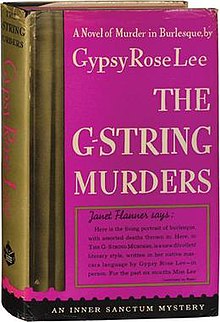The G-String Murders
 First edition | |
| Author | Gypsy Rose Lee or possibly ghost-written by Craig Rice (authorship in dispute) |
|---|---|
| Country | United States |
| Language | English |
| Genre | Mystery, Detective Novel |
| Publisher | Simon & Schuster |
Publication date | 1941 |
| Media type | Print (Hardback & Paperback) |
The G-String Murders is a 1941 detective novel written by famed American burlesque performer Gypsy Rose Lee. There have been claims made that the novel was in fact written by Craig Rice[1] but others have suggested that there is enough documented evidence in the form of manuscripts and correspondence to prove Lee wrote at least a large portion if not the whole of the novel herself under the tutelage of editor/friend George Davis with some essential guidance from her good friend Rice.[2] The novel has also been published under the titles Lady of Burlesque and The Strip-Tease Murders. Set in a burlesque theater, Lee casts herself as the detective who solves a set of homicides in which strippers in her troupe are found strangled with their own G-strings.
In 2005, Feminist Press of the City University of New York republished the book as one of its Women Write Pulp series.
Plot summary
Gypsy Rose Lee narrates her way through a tale of a double murder, backstage at the "Old Opera" burlesque theatre on Forty-Second Street, New York.
In a world populated by strippers, comics and costume salesman. A world where crime is part of the norm and where women struggle to earn a living and have gangster boyfriends.
The narrative is a "wise-cracking" and humorous tale of murder in a burlesque house, and with the unusual weapon of the title.
Characters in "The G-String Murders"
- Gypsy Rose Lee—herself, narrator
- Lolita LaVerne—stripper
- Gee Gee Graham—stripper
- Biff Brannigan—comedian
- Siggy—costume salesman
Literary significance and criticism
"Anyone keen about sex in fiction will admire this workmanlike job for its account of a performing group, its use of technicalities—if that's the word—about stripping, and its handling of the clues by a likeable lieutenant.... This is one of a handful of books about backstage murder that are tolerable. It is not made worse by being told in the first person, or by a bit of sentimental lovey-dovey between the narratrix and one of the cast of characters."[3]
Film, TV or theatrical adaptations
The novel was filmed in 1943 as Lady of Burlesque, directed by William Wellman, starring Barbara Stanwyck as "Dixie Daisy" (the Lee character), Michael O'Shea as her romantic interest, and Pinky Lee, among many notable supporting players. It is a fairly faithful, if bowdlerized, representation, but notable for the addition of music and songs, including "Take it off the E string, play it on the G string" sung by Stanwyck. The film attempts to show what the censors of 1943 would allow it to show with respect to the precise nature of "bumps" and "grinds", and the slapdash nature of burlesque shows.
References
- ^ ,Hubin, Allen J. Crime Fiction, 1749–1980: A Comprehensive Bibliography. New York: Garland Publishing Inc., 1984, p. 243
- ^ Tippins, Sherill. February House: The Story of W. H. Auden, Carson McCullers, Jane and Paul Bowles, Benjamin Britten, and Gypsy Rose Lee, Under One Roof in Brooklyn. Houghton Mifflin Company Publishing, 2005.
- ^ Barzun, Jacques and Taylor, Wendell Hertig. A Catalogue of Crime. New York: Harper & Row. 1971, revised and enlarged edition 1989. ISBN 0-06-015796-8
Sources
- Lee, Gypsy Rose. The G-String Murders. New York: Feminist Press of the City University of New York, 2005; ISBN 1-55861-504-0.
